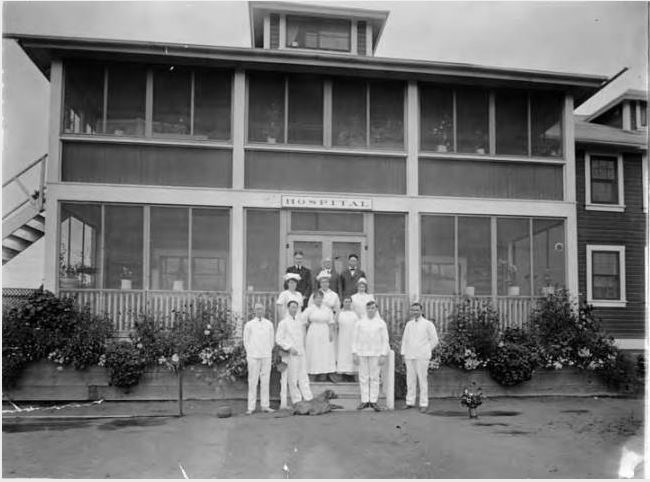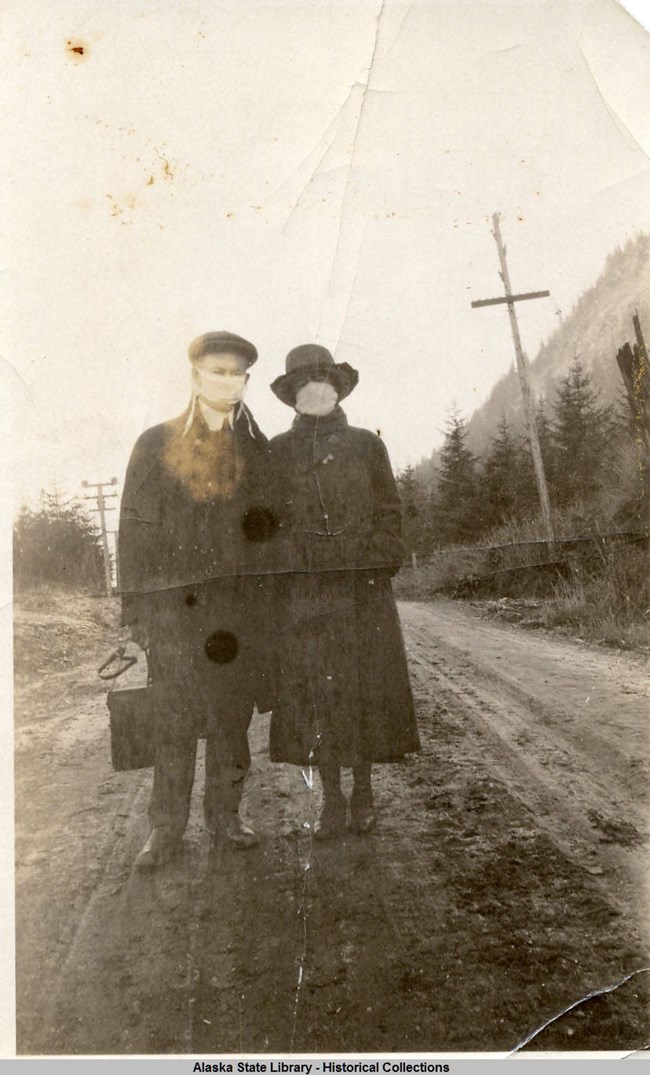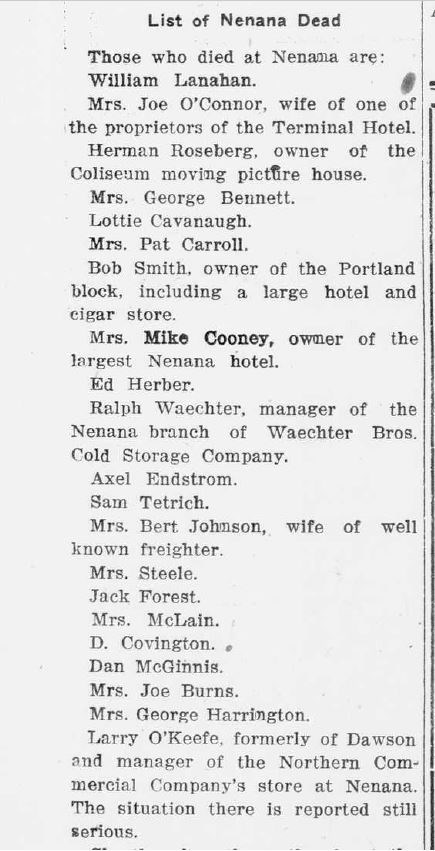Last updated: October 27, 2021
Article
The Flu Pandemic hit Nenana 100 Years Ago

NPS Photo

Almost exactly a month after the Nenana Daily News statement was published telling town residents not to worry, the town was overrun by the flu. So many residents fell ill at once that Nenana was overwhelmed and effectively shut down. In early May 1920, the make-shift hospital was full, the newspaper shut down, the telegraph station shut, railroad travel suspended, and, according to the June 12, 1920 edition of the Cordova Daily Times, a fire department official pleaded with the community “to please not have any conflagrations” because he was unable to fight them single-handedly. In an account published by Reverend Robert Diven in June 1920 (see figure 3), he described people dying because the local health care system was overloaded.

Whole Town has Flu in Alaska
Rev. Robert J. Diven Writes of Experiences During EpidemicAlbany friends of Rev. and Mrs. Robert J. Diven, formerly of the Grace Presbyterian church, will be interested in the following letter to C. M. Grigsby from their home in Nenana, Alaska:
Nenana Alaska, May 26, 1920.
Dear Friends:
We are all nearly well again. Mrs. Diven did not have the flu, but she nursed Lucile and me through it. There were nearly five hundred cases in town, which is more people than we thought we had here—almost every soul in town had it. Sixty odd died. Over two hundred were down at the same. We had great difficulty to keep the dead moving to the cemetery fast enough, for warm weather had set and the ground was thawer [sic] only a little below the surface. The graves took much work, even much blasting. We were short of help to nurse, and that is why some died, perhaps. It was pneumonia in each case that killed the folks. People exposed themselves to the air while sweating. They went quickly. We had a very malignant type of flu here. Fairbanks, with about twelve hundred people had over eight hundred cases and only twenty-some died. They had a very mild form and had all the advantages for handling a lot of people. That is an old-town, a home town. Our town is a new town and more of a camp than a really truly town. It is NOT a home town.
Lucile and I were kept in the chapel while we were sick. It made a dandy little hospital. We are weak yet, but both are eating and doing very well again.

Harry and Carrie Dott Photograph Collection, Alaska State Library Historical Collections, ASL-P593-009
The “Spanish” influenza first arrived in southeast Alaska in the fall of 1918 about the same time that the “second wave” of the pandemic was afflicting the rest of the United States. Between 1918 and 1919, an estimated 51% of all deaths in the Alaska Territory were caused by the flu, and it disproportionately devastated Alaska Native communities, which suffered 82% of the deaths. On a per capita basis, Alaska suffered one of the pandemic’s worst death rates in the world.[3] The near complete annihilation of the Brevig Mission near Nome has garnered recent attention not just because only eight of the village’s eighty residents survived the pandemic, but because the site became significant as scientists, with the cooperation of Inupiak elders, studied strains of the "Spanish" flu.
The fourth wave of the influenza that hit Interior Alaska in 1920 is often left out of the pandemic analyses, possibly because the world-wide deaths had fallen significantly by that point.[4] As we grapple with our own pandemic, it is useful to look to the lessons of the past. What happened in our neighboring community occurred in numerous communities around the globe, but only arrived in this small town after the rest of the world endured devastation and was on the road to recovery. In 1920, like 2020, people came together to help the larger community and lessen the severity of the crisis. Quarantines were put into place, masks were required in certain places, and life changed dramatically for hundreds of millions of people. This week we remember those whose lives were lost and those whose lives were forever altered in Nenana 100 years ago.

List of Nenana Dead
[1920 influenza epidemic]Those who died at Nenana are:
- William Lanshan
- Mrs. Joe O'Connor, wife of one of the proprietors of the Terminal Hotel
- Herman Roseberg, owner of the Coliseum moving picture house
- Mrs. George Bennett
- Lottie Cavanaugh
- Mrs. Pat Carroll
- Bob Smith, owner of the Portland block, including a large hotel and cigar store.
- Mrs. Mike Cooney, owner of the largest Nenana hotel.
- Ed Herber
- Ralph Waechter, manager of the Nenana branch of Waechter Bros. Cold Storage Company
- Axel Endstrom
- Sam Tetrich
- Mrs. Bert Johnson, wife of well known freighter
- Mrs. Steele
- Jack Forest
- Mrs. McLain
- D. Covington
- Dan McGinnis
- Mrs. Joe Burns
- Mrs. George Harrington
- Larry O'Keefe, formerly of Dawson and manager of the Northern Commercial Company's store at Nenana
[1] The “Spanish” influenza received its name because Spain was the first country to report on the outbreak in its newspapers, not because it originated there. There is not absolute certainty about where this influenza originated but a few scholars have argued a likely origin of Haskell County, Kansas.
[2] The 1920 census reports 634 residents in Nenana and 172 residents in the Nenana Native Village. In 1921 the Austin American Statesman published an interview with J.H. Steele, who said Nenana had about 500 residents—about 300 infected and 65 dead. Steele’s wife served as a nurse in Nenana and died of the flu. Rev. Diven’s report (see figure 3) says that nearly everyone in town came down with the flu and “sixty odd died.”
[3] Samoa has been reported as being the only place with a higher per capita death rate than Alaska.
[4] The “fourth wave” of the “Spanish” influenza that spread in 1920 is discussed in American Pandemic: the Lost Worlds of the 1918 Influenza Epidemic by Nancy Bristow, and “Global Mortality of the 1918-1920 ‘Spanish’ Influenza Pandemic” featured in Bulletin of the History of Medicine, Vol. 76, No. 1 (Spring 2002) by Niall P.A.S. Johnson and Juergen Mueller. The four waves of the 1918-20 flu pandemic are temporally defined as: first wave - spring 1918; second wave - fall 1918; third wave - winter/spring 1919; fourth wave - spring 1920.
[2] The 1920 census reports 634 residents in Nenana and 172 residents in the Nenana Native Village. In 1921 the Austin American Statesman published an interview with J.H. Steele, who said Nenana had about 500 residents—about 300 infected and 65 dead. Steele’s wife served as a nurse in Nenana and died of the flu. Rev. Diven’s report (see figure 3) says that nearly everyone in town came down with the flu and “sixty odd died.”
[3] Samoa has been reported as being the only place with a higher per capita death rate than Alaska.
[4] The “fourth wave” of the “Spanish” influenza that spread in 1920 is discussed in American Pandemic: the Lost Worlds of the 1918 Influenza Epidemic by Nancy Bristow, and “Global Mortality of the 1918-1920 ‘Spanish’ Influenza Pandemic” featured in Bulletin of the History of Medicine, Vol. 76, No. 1 (Spring 2002) by Niall P.A.S. Johnson and Juergen Mueller. The four waves of the 1918-20 flu pandemic are temporally defined as: first wave - spring 1918; second wave - fall 1918; third wave - winter/spring 1919; fourth wave - spring 1920.
